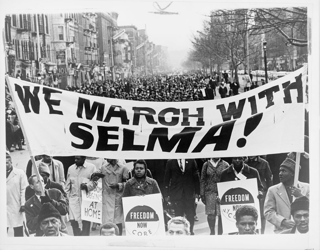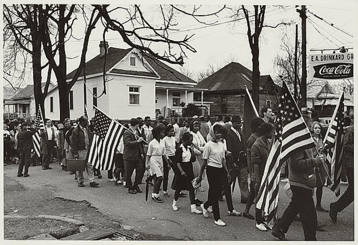Whether you are searching for a new graphic novel to buy the kids or teenagers in your life, or if you are adding to an ever-expanding graphic novel collection of your own, we want to make sure you know about the March Trilogy. This three-book set from John Lewis, one of the key figures of the American Civil Rights Movement and current Georgia congressman, is a memoir about his “coming-of-age in the movement,” according to an article in The New York Times about the graphic memoir collection. The books are significant for anyone hoping to learn more about the history of the Civil Rights Movement and Lewis’s experiences, and they are also important guidebooks for future leaders who are willing to make “necessary trouble,” as Lewis has described the act of protest.
“To the Past and Future Children of the Movement”

When you find yourself at the dedication page of March: Book One, you’ll see that John Lewis dedicated the first book “To the past and future children of the movement.” The book opens with an image of the Edmund Pettus Bridge, the site of the 1965 voting rights march from Selma to Montgomery. The first graphic image depicts the start of a day that became known as “Bloody Sunday” when Alabama state troopers violently beat demonstrators on the bridge for exercising a right to peaceful protest.
While the books are at once memoir, they are also about the power of collective action and the power of protest. As The New York Times article suggests, “young people deserve a future in which they can conceive of their own participation, and this requires a past that, however long the shadow of its achievements, begins at their scale,” and March has the power to inspire younger generations to engage and to speak out against civil rights violations in the twenty-first century.
Winner of National Book Award for Young People’s Literature

The series of March books culminated in Book Three, which was the winner of the 2016 National Book Award for Young People’s Literature. The third volume was co-authored by Lewis, Andrew Aydin, and Nate Powell. According to an article about the book’s award in The Washington Post, the graphic novel project arose “because Aydin, the digital director in Rep. John Lewis’s office, was a comic-book fan—a passion deeply appreciated by his boss.”
In the CBS series “Note to Self,” Lewis reflected on his involvement in the Civil Rights Movement. In many ways, these reflections mirror some of the themes in March. Lewis says, “I say to you now, when you see something that is not right, not fair, not just, you have a moral obligation to continue to speak, to speak out.” He goes on to discuss the significance of the march in Selma:
“Two years after you speak at the March on Washington, you will see the face of death leading the march for voting across the Edmund Pettus Bridge in Selma. You were beaten on that bridge. You were left bloody. You thought you were going to die. But you will make it. You will live to see your mother and father cast their first votes.”
The National Book Foundation asked Lewis who he wrote the book for, and we will leave you with more of his words:
“This book is for all of America. It is for all people, but especially young people, to understand the essence of the civil rights movement, to walk through the pages of history to learn about the philosophy and discipline of nonviolence, to be inspired to stand up to speak out and to find a way to get in the way when they see something that is not right, not fair, not just.”
All three books are now available as a set. Why not pick up a copy today?









